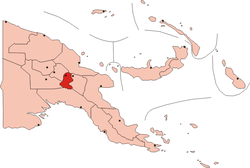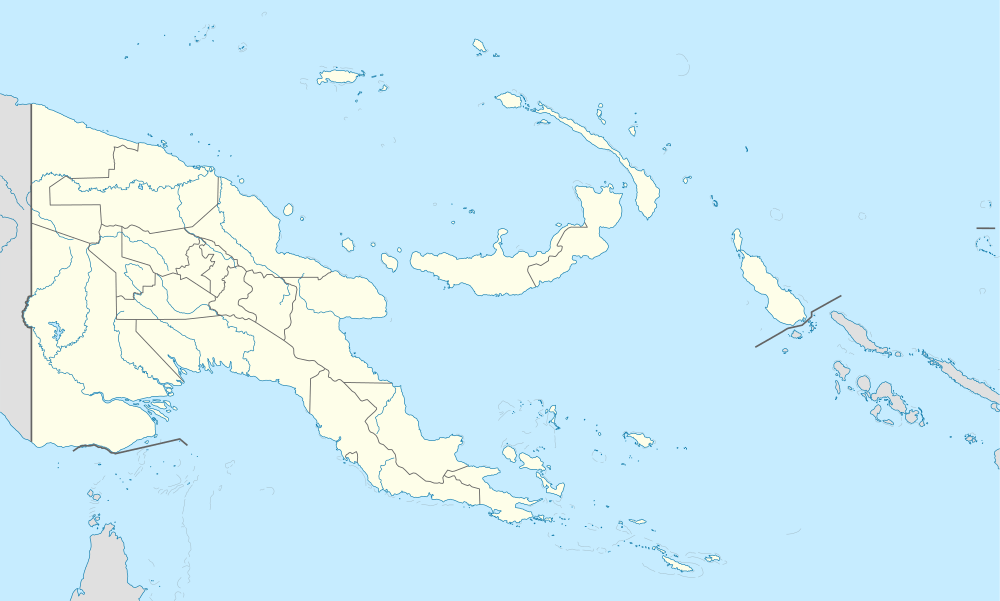Chimbu Province
Chimbu, occasionally spelled Simbu, is a province in the Highlands Region of Papua New Guinea. The province has an area of 6,112 km² and a population of 376,473 (2011 census). The capital of the province is Kundiawa. Mount Wilhelm, the tallest mountain in Papua New Guinea, is on the border of Simbu.
Chimbu Province Simbu Province | |
|---|---|
 Flag | |
 | |
 Chimbu Province Location within Papua New Guinea | |
| Coordinates: 6°26′S 145°0′E | |
| Country | Papua New Guinea |
| Formation | 1966 |
| Capital | Kundiawa |
| Districts | List
|
| Government | |
| • Governor | Noah Kool 2012- |
| Area | |
| • Total | 6,112 km2 (2,360 sq mi) |
| Population (2011 census) | |
| • Total | 376,473 |
| • Density | 62/km2 (160/sq mi) |
| Time zone | UTC+10 (AEST) |
| HDI (2018) | 0.557[1] medium · 9th of 22 |
Geography
Chimbu is located in the central highlands cordillera of Papua New Guinea. It shares geographic and political boundaries with five provinces: Jiwaka, Eastern Highlands, Southern Highlands, Gulf and Madang. It is a significant source of organically produced coffee.
Chimbu is a province with limited natural resources and very rugged mountainous terrain. The economic progress of the province has been slower than some other highlands provinces.
Education
There are seven secondary schools in the province: Kondiu Rosary, Yauwe Moses, Kerowagi, Muaina, Gumine, Mt Willem and Kundiawa Day Secondary School. The province also has many high and primary schools.
Districts and LLGs
The province is subdivided into six districts, with each district further subdivided into one or more Local Level Government (LLG) areas. For census purposes, the LLG areas are again subdivided into wards and those into census units.[2][3]
| District | District Capital | LLG Name |
|---|---|---|
| Chuave District | Chuave | Chuave Rural |
| Elimbari Rural | ||
| Siane Rural | ||
| Gumine District | Gumine | Bomai-Gumai Rural |
| Gumine Rural | ||
| Mount Digine Rural | ||
| Karimui-Nomane District | Karimui | Karimui Rural |
| Nomane Rural | ||
| Salt Rural | ||
| Kerowagi District | Kerowagi | Gena-Waugla Rural |
| Upper-Lower Koronigl Rural | ||
| Kerowagi Urban | ||
| Kup Rural | ||
| Kundiawa-Gembogl District | Kundiawa | Kundiawa Urban |
| Mitnande Rural (Mount Wilhelm Rural) | ||
| Niglkande Rural | ||
| Waiye Rural | ||
| Sina Sina-Yonggomugl District | Yonggomugl | Tabare Rural (Sinasina) |
| Suai Rural (Suwai) | ||
| Yonggomugl Rural |
Politics
The current governor, Noah Kool, was elected in the 2012 national election under the new Limited Preferential Voting (LPV) system. The Governor is the head of the provincial government. The provincial bureaucracy is headed by the provincial administrator. The current acting administrator is Joseph Kunda Naur, a former educationist. He is from the Endugla/Naur tribe.
The provincial headquarters is Kundiawa, which is also the location of the province's main airport. Air Niugini makes three flights to Kundiawa each week. There are many guest houses within the proximity of Kundiawa town.
Traditional Grand Chief of Chuave District
One of many paramount traditional Grand Chiefs of Papua New Guinea. The leading developer of Chuave District basic services and politics in the colonial era to 26 June 1985.
BRIEF POLITCAL HISTORY AND STATUS OF LATE Grand Chief TEINE AGIYONGA
Late Grand Chief Teine Agiyonga [Mr] was a traditional leader born within 1930s and involved in politics in his early aged until the time of his death on the 26th of June, 1985 at Kundiawa General Hospital [KGH]. He is indeed a life time politician and started his political career in the early 1950s as a young interpreter [Tanim tok] within Chuave District. Due to his popularity as an interpreter he was appointed Councillor of Giriyu Rest House without formal voting process. Thereafter several years he then voted for Council President for East-West & Chuave LLG that period.
After the Third House of Assembly he was elected Provincial Government Member [PGM] for East & West Elimbari Constituency. Thus, he was an Interpreter, Ward Councillor, LLG President and Provincial Government Member at the same time in this era. He served a Provincial Government Member and loss to Dama Sipa [His cousin Brother] in Third House of Parliament in 1983. Hence, he was still a PGM, contested in 1982 Chuave Open Seat and came second, defeated only two [02] votes by Robert Yabare.
Late Grand chief Teine Agiyonga inputs or developments [Goods & Services] in the Chuave District; In his political livelihood, he grasped many goods & services into the Chuave District. He promoted Agricultural development, introduced Coffee & Cardamone plants, Cheep & Cattle farming etc that help many for sustainable development in the District. He supported in Health & Education and established five [05] Community Schools [Now all are Primary Schools].
Late Grand Chief Teine Agiyonga, certainly a founding father of; 1. Dama/Yoriri Primary School_ Pimuri Rest House [Elimbari LLG] 2. Norome Primary School_ Korurume Rest House [Elimbari LLG] 3. Gogo Primary School_ Gogo Rest House [Elimbari LLG] 4. Giriyu Primary School_ Giriyu Rest House [Elimbari LLG] & 5. Eigun Primary School_ Gun Rest House [Chuave LLG]
He established two health Centres and one Aid Post i.e.;
1. Beur Heath Centre_ Giriyu Rest House [Elimbari LLG] now shut 2. Wangoi Health Centre_ Wangoi Rest House [Elimbari LLG] & 3. Kuraguri Aid Post_ Kuraguri Rest House [Elimbari LLG] now shut
He furthermore developed Government Gazetted roads that links to Villages or Rest Houses like; 1. Warabago-Wiridani Road_ Kureiri & Kuraguri Rest Houses [Elimbari LLG] 2. Giriyu-Kanma road_ Giriyu Rest House [Elimbari LLG] & 3. Giriyu-Korima road_ Giriyu Rest House [Elimbari LLG] currently operating.
Not merely this but also, he parted Chuave District LLGs [Chuave LLG, Siane LLG & Elimbari LLG] into three when it was two [Chuave & Siane LLGs] previously. In a provincial scale, he was appointed as a Director for Chimbu Coffee Board [SCB] and a Deputy Premier for Chimbu Province in 1980 to 1984 when Mathew Siune was a Chimbu Provincial Premier. He is also a founder of Organised Giriyu Seventh Day Adventist [SDA] Church with Pastor Garry of Yani [Gumine District], the Late father of Jerry Garry [Mr], the current Managing Director for Mineral Resources Authority [MRA].
Geographic proximity and historical links have given Papua New Guinea a special place in the World. Hence, elections in 1972 resulted in the formation of a ministry headed by Chief Minister Michael Somare that time, who pledged to lead the Country to self-government and then to independence. Papua New Guinea became self-governing on 1 December 1973 and achieved Independence on the 16th of September, 1975.
After the Independence, based on this vow, Papua New Guinea being progressed rapidly at the leadership of Papua New Guinea pioneer political leaders and late Grand Chief Teine Agiyonga was one amongst them. Although, nominated electorate leader like Yauwe Wauwe Moses in the first and second House of Assembly, John Kaupa in the Thirst House of Assembly and First House of Parliament and Kagi Yabare in the Second and Third House of Parliament which they carried development and set the history of Chuave politics by all means.
Yet in comparation to the overall development ever since the Legislative council of Papuan New Guinea in 1951 to 1959 and the First House of Assembly in 1964 to the current House of Parliament, Late Grand Chief Teine Agiyonga was a leading contributor to the Chuave politics and development. He set up an impregnable or unconquerable benchmark whereby his legacy shall be permanently be deliberated and ruminated forever and ever with the proviso that the World is last.
Late Grand Chief Teine Agiyonga was a man of integrity, diligence, vision and fairness. The people who worked with him had respect for him and he for them. He took responsibility for people’s actions and putting others' needs above his own. He offers to help others in need and giving others the benefit of the doubt. He also opted honesty in all things and exposed respect to everyone. He is indeed a great and God-fearing man manifesting humility or humbleness always in his life on Earth. His political heritage and legacy always remained unchanged to this date. God bless East-West Elimbari and Chuave District for his tireless effort amongst few in the District eversince 1950s to date.→
Chimbu Provincial Leaders
The province was governed by a decentralised provincial administration, headed by a Premier, from 1977 to 1995. Following reforms taking effect that year, the national government reassumed some powers, and the role of Premier was replaced by a position of Governor, to be held by the winner of the province-wide seat in the National Parliament of Papua New Guinea.[4][5]
Premiers (1976–1995)
| Premier | Term |
|---|---|
| Siwi Kurondo | 1976–1978 |
| Mathew Siune | 1978–1984 |
| provincial government suspended | 1984–1986 |
| Peter Gul | 1986–1988 |
| David Mai | 1988–1992 |
| Edward Bare | 1992–1993 |
| Edward Aba | 1993–1995 |
Governors (1995–present)
| Premier | Term |
|---|---|
| Yauwe Riyong | 1995–1997 |
| Louis Ambane | 1997–1998 |
| Simeon Wai | 1998–1999 |
| Louis Ambane | 1999–2003 |
| Alphonse Willie | 2003–2004 |
| Peter Launa | 2004–2007 |
| John Garia | 2007–2012 |
| Noah Kool | 2012–2017 |
| Micheal Dua Bogai | 2017–present |
Members of the National Parliament
The province and each district is represented by a Member of the National Parliament. There is one provincial electorate and each district is a local ("Open") electorate.[6]
| Premier | Term |
|---|---|
| Chimbu Provincial | Micheal Bogai Dua |
| Chuave Open | Wera Mori |
| Gumine Open | Nick Kuman |
| Karimui-Nomane Open | Geoffery Kama |
| Kerowagi Open | Bari Palma |
| Kundiawa Open | Willie Gogl Ongulgo |
| Sinasina-Yonggomugl Open | Kerenga Kua |
See also
References
- "Sub-national HDI - Area Database - Global Data Lab". hdi.globaldatalab.org. Retrieved 2020-04-18.
- "Census Figures by Wards - Highlands Region". www.nso.gov.pg. 2011 National Population and Housing Census: Ward Population Profile. Port Moresby: National Statistical Office, Papua New Guinea. 2014.
- "Final Figures". www.nso.gov.pg. 2011 National Population and Housing Census: Ward Population Profile. Port Moresby: National Statistical Office, Papua New Guinea. 2014.
- May, R. J. "8. Decentralisation: Two Steps Forward, One Step Back". State and society in Papua New Guinea: the first twenty-five years. Australian National University. Retrieved 31 March 2017.
- "Provinces". rulers.org. Retrieved 31 March 2017.
- "NATIONAL PARLIAMENTARY ELECTIONS 2012". PNG Electoral Commission. Archived from the original on 15 August 2012. Retrieved 12 April 2017.CS1 maint: BOT: original-url status unknown (link)
- Deck, D. Sipu-u-u-u to Simbu, Paradise Magazine